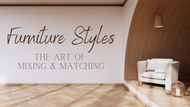Furniture Styles - The Art of Mixing and Matching
23rd May 2024
How you design a space, specifically a home, is a reflection of your personal style and taste. Different elements of your lived experience and preferences come together to create a space for you and your family to enjoy. Mixing and matching furniture styles allows your to showcase what makes you YOU and adds depth to your space. In this article, we will explore the art of mixing and matching furniture styles to help you create your perfect space.
In order to explore the art of mixing and matching furniture styles, we must first solidify our understanding of various furniture styles:
Modern - clean lines, minimalism, focused on functionality; mix of materials like metal, glass, and wood
Traditional - inspired by historical periods; known for ornate details, rich wood finishes, and classic upholstery
Contemporary - reflects present design trends; incorporates elements from modern and other styles
Rustic - natural and weathered look; often features raw wood, stone, and earthy colors
Industrial - rugged, utilitarian aesthetic inspired by factories and warehouses; materials like steel and distressed wood
Mid-Century Modern - known for simplicity, organic shapes, and bold use of color
Bohemian - culturally influenced; characterized by bright colors, patterns, and a relaxed, free-spirited vibe
To mix and match furniture styles in the most effective manner, you must find a balance between contrasting and complementary styles to create cohesion in a space. Some key principles to consider include:
- Identify a focal point. Choose an anchor piece that will serve as a centerpiece for the space. This can serve as a focal point and also a conversation starter. This could be a unique piece of furniture like a bold-colored armchair, an interesting light fixture, or an eye-catching rug - these statement pieces can inject your unique style into your space.
- Understand your design aesthetic. Your personal style can serve as your guide for selecting the right pieces that mix together well. Things to consider are: dominant style, color palette, textures, and mood. Look at various inspiration rooms and spaces to help identify and understand your personal design aesthetic.
- Introduce contrast. Using your dominant style as a foundation, add contract into your room by incorporating other styles - this will create visual stimulation. For example, if your dominant style is modern, use a traditional or rustic piece to create visual interest, or pair a modern sofa with a rustic wooden coffee table.
- Maintain a color scheme. Select a color scheme that goes with your design aesthetic and stick to it throughout your space. This consistency will tie together different styles through wall color, upholstery, trinkets, wall art or curios. Using one of the many tools online to view what different color palettes look like in spaces can be helpful in deciding what you want.
- Ensure balance, proportion and scale. It is essential to maintain a balance alongside your creative freedom so that you achieve a harmonious look. Think about the size and concentration of furniture items to avoid overcrowding and leaving room for easy circulation.
- Layer textures and patterns. Consider layering textures and patterns through furniture and accessory choices. This could look like mixing smooth and rough textures or adding multiple patterns like stripes, geometrics and florals. This layering can make your design more dynamic and add depth.
- Embrace what you like. Make sure to utilize your personal style as a guide and don't be afraid to mix styles! Pairing antique pieces with contemporary or blending mid-century modern with art deco can result in a visually stimulating space. Don't be afraid to combine unexpected pieces, experiment with colors, and blur the lines between different styles.

